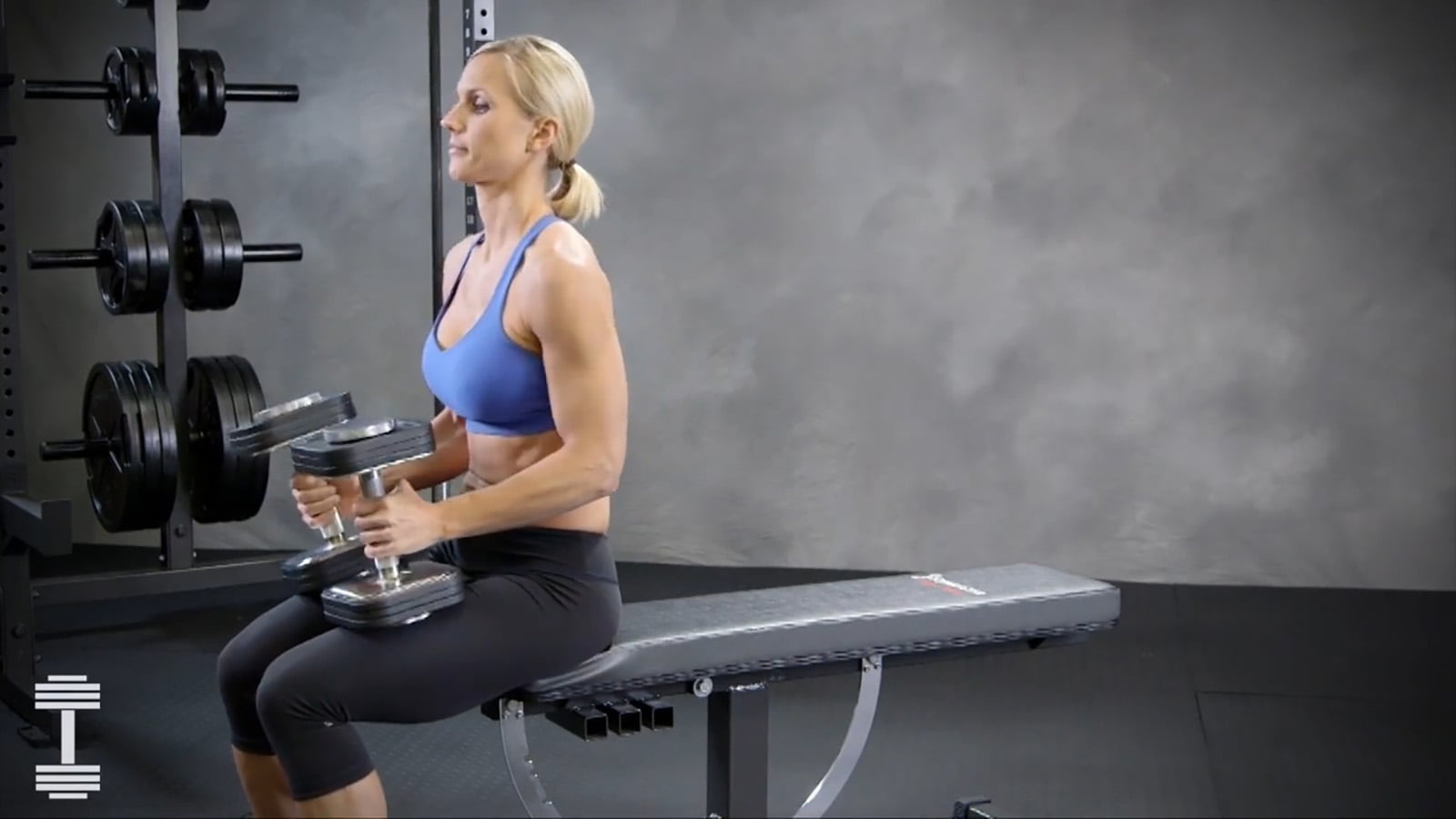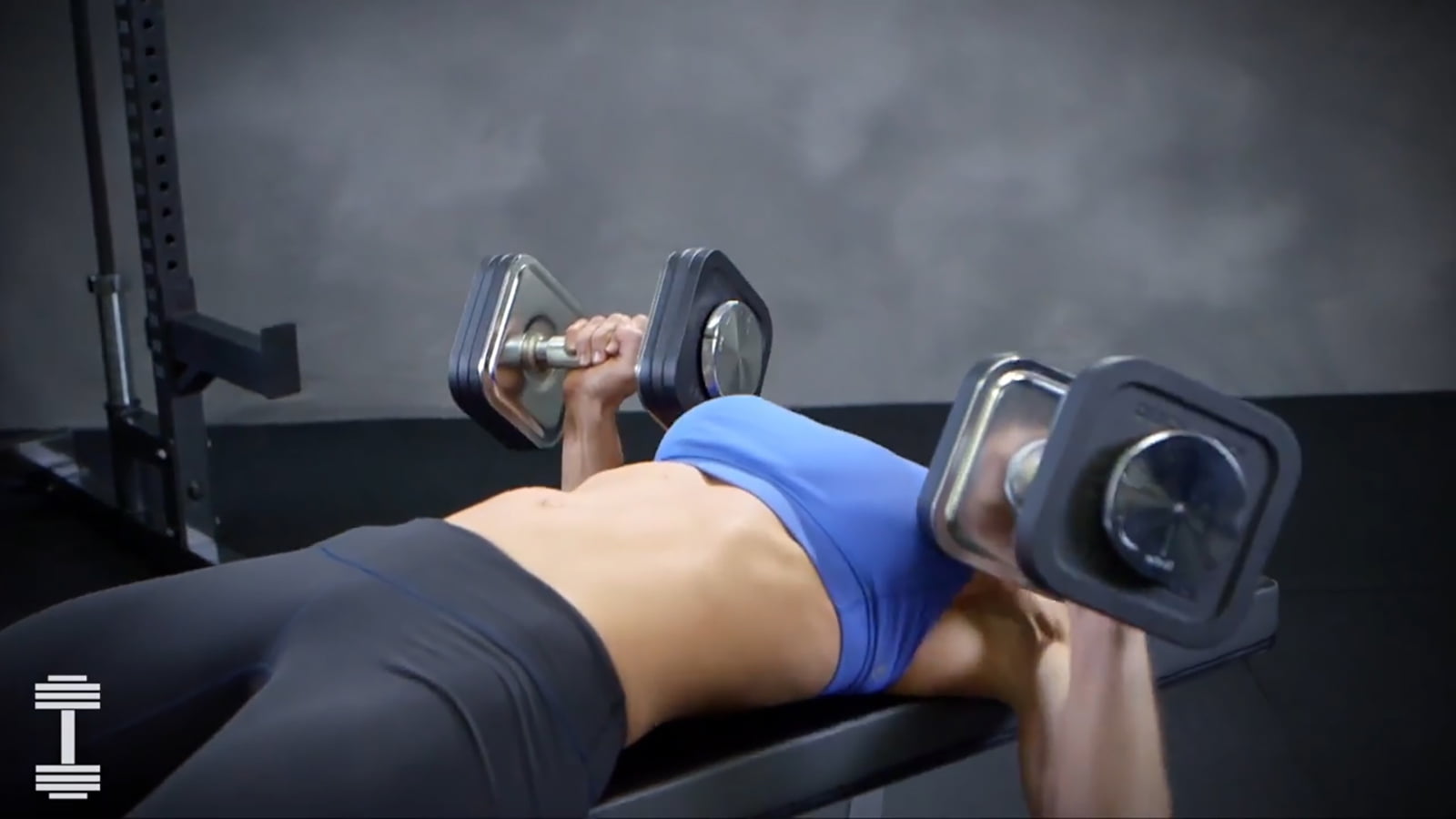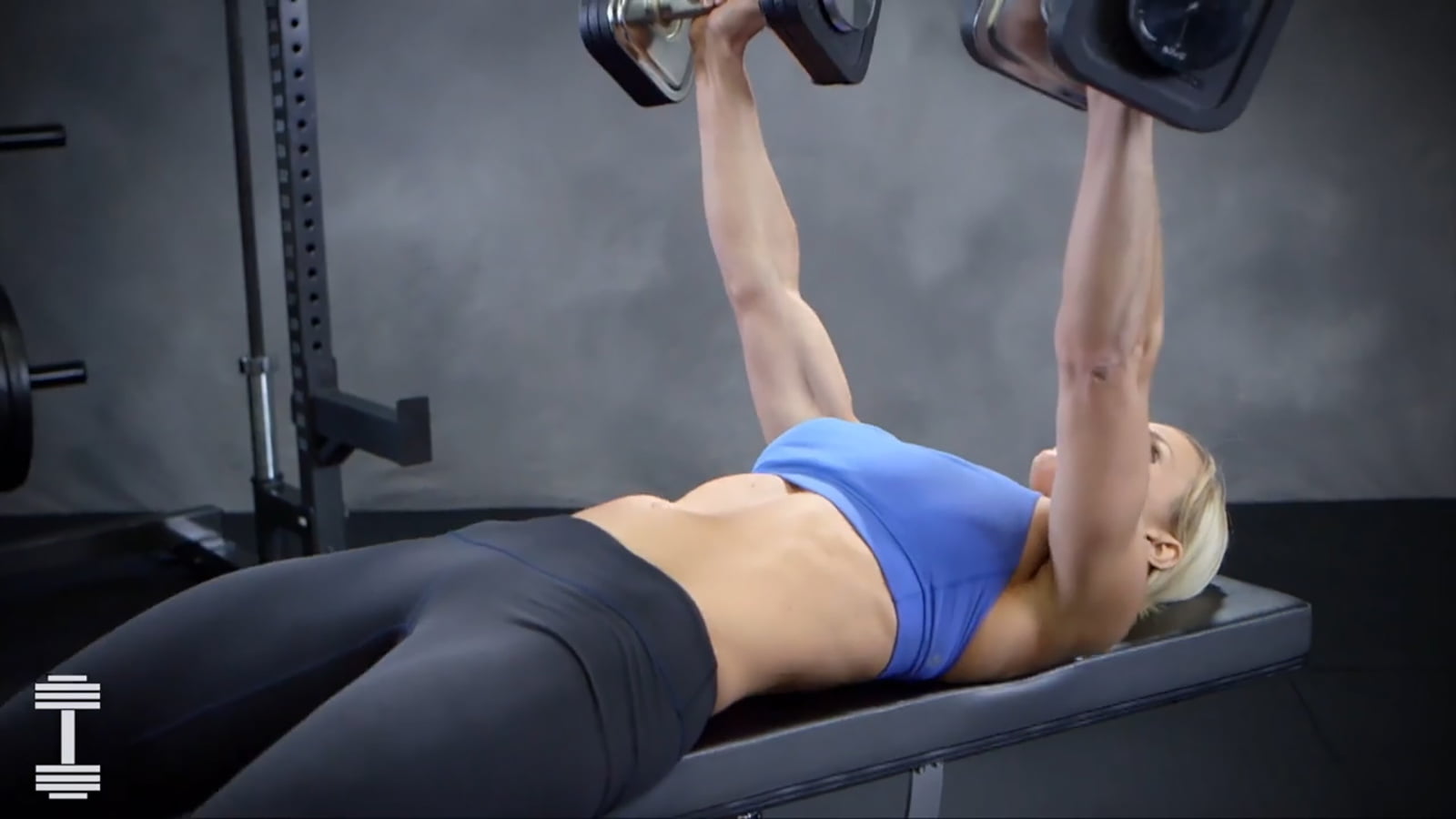Flat Dumbbell Chest Press
When I first started training over 10 years ago, my first serious training program included the flat dumbbell chest press exercise.
As the years went by, my training goal shifted from getting big to being strong. What has not changed is the dumbbell chest press in my workouts.
That is because the flat dumbbell chest press is one of the best exercises you can do if you want to build a stronger/bigger chest in a relatively safe and effective way.
Muscles Used
The core three muscles groups which are used in the flat dumbbell press would be Chest, Triceps & Shoulders.
Of course, you would be activating other muscle groups, but they would get significantly less load (lats, forearms, trapezius).
It is possible for you to shift the load between your chest and triceps, based on your hand position and how you are performing the overall movement.
But, before we go through the variations, let us address the most important thing – the form.
The safest way to bring the dumbbells into the starting position?
The flat dumbbell press is a relatively safe exercise if you know the tricks of getting the dumbbells into position, and then returning them to ground when the final repetition is completed.
There are a few ways you could place yourself in a perfect position:

- Dumbbells on your knees – probably the most popular way when it comes to setting up. Just place the dumbbells on your knees, while you are sitting down, then bring your arms closer to your chest and lay down. The momentum of laying down will assist you in getting the dumbbells into the start position.
Just please do not sit in the middle of the bench when you are laying down. Put your bum on the bench where the bum is meant to be – the seat pad!
- Curling the dumbbells while you are laying on the bench – this is the laziest and the least safe way to bring the dumbbells up into the pressing position. Needless to say, you can press way more than you can bicep curl and so you are risking a potential bicep injury using this method.
- Dumbbell spotting stands – once you find the right height and angle, the dumbbell stands are the safest and most effective way to bring the dumbbells to the starting position. The downside is that they are an additional piece of gym equipment so there will additional cost and space required.
- Your mate – if you are lucky enough to have a training partner who is willing to deadlift the heavy dumbbells into your paws, go for it. Your training partner can only hand you one dumbbell at a time, so you will have to hold one dumbbell in position while they get the other.
Lowering the dumbbells is a reverse of the methods above. But the safest way, in terms of injury to yourself, others and gym equipment, is placing the dumbbells back on the knees and sitting up. Once you get experience, the momentum of placing the dumbbells on your knees will assist you in sitting up.
Dropping dumbbells not only is disrespectful to the gym owner, or if you train at home you will be damaging your equipment. But it is also risky in that you must control the dumbbells to the ground to some degree, but if you control too much you risk tearing a muscle.
This is what Lee Priest has to say on the matter:
During the exercise:
Breathing
There are two breathing techniques that can be used:
Breathing out during the pressing movement – ideal if you are going for multiple repetitions and not trying to press the heaviest dumbbells in the gym. In the perfect world, you would breathe in before you commence the lift and breath out as you are pushing the dumbbells up. This type of breathing will allow you to reap the benefits of intra-abdominal pressure without the fears of passing out due to extremely high blood pressure and lack of oxygen.
Holding the air in – this is the type of breathing which most powerlifters or strongmen would use while lifting heavy. You would breathe in before the lift and breathe out once you have locked your elbows out. This would give you the best possible stability, but the downside is that it would raise your blood pressure. Perfect for exercises with low repetitions. Not recommended for beginners.
Tension, Leg Drive & Arch

Should you arch your back during dumbbell chest press? The answer is yes. You would be bringing the dumbbells just a tad lower compared to your regular straight barbell. Without arch, you would not be able to bring the dumbbells to the desired position without starting to pinch your rotator cuff muscles.
How to arch: Just clench your shoulders together, bring them down and keep them there while you are pressing.
Your overall body stability during flat dumbbell press, has a lot to do with the leg drive and the tension in your body. What I mean by tension is – tensing your whole body before starting the lift and keeping it tensed throughout the whole movement.

Your legs would act as an anchor during the exercise. This way you would have much more control over your dumbbells, as well as greatly reducing a chance of injury.
Proper leg drive and body tension will bring you the optimal stability while you are training. But what if you decide to put your legs on the bench and lay flat on your back?
I would not recommend it.
Flat Dumbbell press is an accessory exercise, chances are you are doing it after heavy bench press and your stabilisers would already be fatigued.
I believe that by lifting your legs off the ground, you are losing stability and you are wasting your energy trying to control the dumbbells rather than using it to press them.
Variations
The best thing about dumbbells is that they allow you to perform multiple variations of the same exercise without the need for additional equipment.
Overhand
This variation is probably most common amongst weight trainers and it also happens to be the simplest one.
The overhand flat dumbbell press allows you to bring the dumbbells down into a deeper groove compared to your regular straight barbell. Which would give you a better stretch at the bottom of the movement.
Neutral
A slightly less used dumbbell chest press variation, but an important one for powerlifters and people with shoulder problems.
The neutral grip (the dumbbell head pointing towards your shoulder) would put significantly more load on your triceps, compared to your regular overhand grip.
Personally, I prefer this grip as this variation is slightly less taxing on your shoulders. Which makes it a perfect accessory exercise, especially after some sets of heavy barbell bench press.
Twist
The dumbbell twist is a great way to get that peak contraction of your chest muscles at the top of the movement.
You would start the movement with a neutral grip and rotate the dumbbells slowly to an overhand grip as you are bringing the dumbbell down.
As you are pushing the dumbbell back up, try gently touching the bottom ends of the dumbbells at the very top for the peak contraction of your chest.
Equipment Required
This might seem self-explanatory – you need dumbbells and a bench – but can you perform this exercise if you do not have a bench? The good news is that you can, and for some, it is recommended.
Without a bench, you can perform the floor press. You will not have the same range of motion as you will get when using a bench, but this can be a good thing.
The floor press is commonly used by athletes in contact sports like rugby league where they frequently get serious shoulder injuries. The restricted range of motion of the floor press will let them work on their pressing power while protecting the pre-existing shoulder injuries.
Who should perform this exercise
Unless you have an injury that prevents you from doing it, the dumbbell chest press is beneficial for trainers of all experience levels and disciplines. Developing strength and muscle in both the chest and shoulders is critical not only in athletic pursuits but also day to day living.
If you are too weak to perform push-ups, even on your knees, you can use light dumbbells. There is so much recent research highlighting the benefits of resistance training for the elderly. Dumbbell chest press allows them to increase their upper body strength slowly and safely.
The opposite also applies. If you are an experienced trainer and can do push-ups for days, you can perform the chest press with heavier dumbbells. Bodybuilders training for Mr Olympia will use the dumbbell chest press because it is one of the most effective ways of overloading the chest muscles.
The final word
Over the years there have been some very complicated and expensive machines designed to build bigger and stronger chest muscles. Some are great and are highly effective. Others are not.
They all struggle to match the balance of cost-effectiveness, safety, and functionality of the humble dumbbell chest press. Yet another wonder of weight training where sometimes the simplest things are the most effective.
